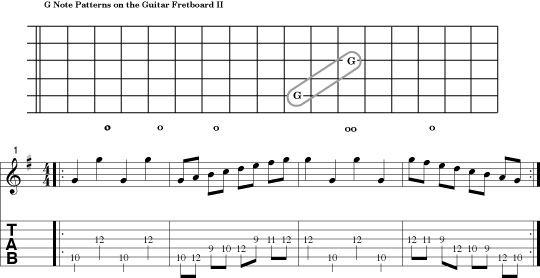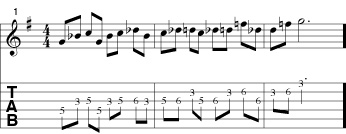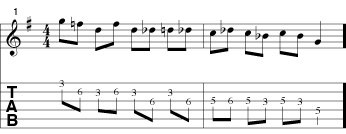Homework Answers
In the book Flatpicking the Blues Brad Davis
assigned a number of "homework" problems for you to work through. On
this page of the website we will provide you with some answers to those
homework problems. If you have any questions, feel free to contact us by
clicking <here>. Please include "Flatpicking the Blues" in the subject line of all correspondence.
Homework Assignment #1: Find the Scales (page 10)
This homework assignment required you to figure out the scale
degrees of several major scales (C, A, E, B, & F) using the
half-step/whole-step formula for the major scale. To find out if your
answers to this problem is correct, please simply turn to page 9 of the
book and compare your answers to the chart at the bottom right of the
page.
Homework Assignment #2: G Major Scales (page 13)
In this assignment you were required to find G Major scales
with the starting point being at various G note locations all over the
guitar neck. Click <here>
to see a graphic an example of a number of the possible major scales
which you can find by starting at the G note at the third fret of the
low E string. If you try to find as many scale patterns as you can for
each G note, your familiarity with the entire fingerboard will improve
greatly.
Note: You will notice that the first G scale
pattern is only on one string. While playing a scale in this manner may
seem impractical, practicing scales along one string for a while (which
would include playing some tunes using that scale and improvising) is a
very good way to practice becoming familiar with how to move up and
down the fingerboard. I heard about this idea from someone who had
studied Mick Goodrick's book, The Advancing Guitarist. I
haven't seen the exercise as explained in the book, but evidently the
exercise entails practicing the guitar as a "uni-tar" single-stringed
instrument, meaning that everything you play is along one string. When
you get to the free-form improvisation practice later in the book, try
improving using the G blues scale on one string only. Then try it on two
strings only, etc. This exercise will help you learn how to jump up to
higher positions (and back from higher positions to lower positions) on
the fingerboard with quickness and accuracy.
The lesson here is to not let yourself get focused on scales
that run across the fingerboard (in box patterns). Practice scales that
move up and down the length of the fingerboard can also be very helpful
(for practice with these scales see the "scales" section of this
website). And note that when we refer to "practicing scales" that does
not necessarily mean running mindlessly up and down the scale. The best
way to practice is to learn the scale, become familiar with it, then use
it in the conext of a song or free-form improv.
Homework Assignment #3: G Major Scales Revisited (page 15)
In this assignment you were required to explore the G Major
Scales at various positions on the guitar fingerboard based on G-note
patterns. In this answer, we will explore just one of those patterns and
leave it up to you to examine others in a similar manner. We will
explore the scale pattern created when using the G-note pattern shown at
the bottom of page 14 (second G-note pattern example). Play through the tab shown below. Recognize that this same scale pattern
also applies to the G scale starting at the G note on the third fret of
the low E string as shown in the graphic at the bottom of page 15 of the
book.


Homework Assignment #4: G Blues Scale Upper Octave (page 27)
In this assignment you were asked to find various ways to
play the G blues scale in the upper octave on the first five frets.
Click <here> to view three different ways that you might play this scale.
Homework Assignment #5: G Blues Scale Ascending and Descending (page 29)
On the DVD Brad Davis played the G Minor Blues Scale in
ascending and descending patterns in the lower octave (as shown on page
29 of the book). Your assignment was to play those same two patterns in
the upper octave. See below to view tab and standard notation of these two patterns.
Ascending

Descending

Homework Assignment #6: Connecting the Patterns (page 30)
In this homework assignment you were called upon to connect
the ascending and decending G minor blues scale patterns shown in the
book with the ones you worked out yourself in homework assignment number
5. See the answer to both of these ascending and descending two-octave patterns below.
Ascending

Descending

Homework Assignment #7: Listen to the Blues (page 57)
In this assignment we simply asked you to listen to some
blues artists and some bluesy bluegrass artists. There is no real
"answer" to this assignment, however, just so you can take a look at a
great bluesy solo by a bluegrass artist, you can click <here>
and get a cool blues inspired transcription of Charles Sawtelle's solo
to "Rocky Road Blues." We will post more blues licks and phrases from
other great blues artists and bluegrass artists in the future. Notice
Charles' use of the blues scale in the first part of the solo. Also
notice his great use of double stops. Charles said that the lick in
measures 15 through 18 was something that he took from a Chuck Berry
solo.
Homework Assignment #8: Nine Pound Hammer (page 73)
In this assignment you were called upon to come up with your
own blues inspired arrangement of "Nine Pound Hammer." There is no
"correct answer" to this one. I (DanMiller) worked up my own version
while doing this homework assignment. It is a bit more straight forward
than the examples Brad gives in the book and I tried to stay very close
to the blues scale. Click <here> to view the version that I came up with. This will give you another example to work with.
If you look at the various blues examples and are still
having trouble with the idea of song arrangement, I have provided a
short step-by-stpe lesson on how to arrange your own solos using "Nine
Pound Hammer" as the example. To work though the lesson, click <here>.
If you are having trouble coming up with something on your own, send us an email. Maybe we can help. Click <here> to contact us. Please include "Flatpicking the Blues" in the subject line.
Homework Assignment #9: Give Your Tunes the Blues Treatment (page 81)
In this assignment we asked you to work on adding a blues
influence to some of the tunes that you already know how to play. Again,
there is no "correct answer" to this one. The more you do it, the
better you are going to get at it. In order to give you a place to
start, we have provided you with a couple of ideas that would work for
the opening four measures of the tune "Salt Creek." Click <here> to check those out.
Once again, if you are having any trouble here, send us an email. Maybe we can help. Click <here> to contact us. Please include "Flatpicking the Blues" in the subject line.
Homework Assignment #10: Key of E Improvisation (page 85)
In this assignment you were asked upon to go through all of
the exercises in the book in the key of E. This will take you some time,
but it is well worth the effort. Try to transcribe all of the scales
and exercises that Brad shows in the key of G over to the key of E. Then
try to go through all of the free-form improvisation exercises in the
key of E. Brad plays an improvised solo in the key of E at the very
beginning of the DVD. Listen to that tune and then click <here>
to see a transcription of that solo. This tune might give you some
ideas for the key of E. If you are having difficulty, maybe we can help.
Click <here> to contact us. Please include "Flatpicking the Blues" in the subject line.